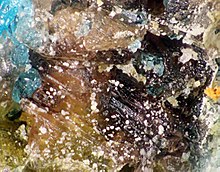Quenstedtite: Difference between revisions
Appearance
Content deleted Content added
Added image |
No edit summary |
||
| Line 59: | Line 59: | ||
[[Category:Iron(III) minerals]] |
[[Category:Iron(III) minerals]] |
||
[[Category:Triclinic minerals]] |
[[Category:Triclinic minerals]] |
||
[[Category:Minerals in space group 2]] |
|||
{{Sulfate-mineral-stub}} |
{{Sulfate-mineral-stub}} |
||
Revision as of 22:56, 29 December 2020
| Quenstedtite | |
|---|---|
 | |
| Allgemein | |
| Kategorie | sulfate minerals |
| Formula (repeating unit) | Fe2(SO4)3·11H2O |
| Strunz classification | 7.CB.65 |
| Crystal system | Triclinic |
| Crystal class | Pinacoidal (1) (same H-M symbol) |
| Space group | P1 |
| Unit cell | a = 6.184 Å, b = 23.6 Å c = 6.539 Å; α = 94.18° β = 101.73°, γ = 96.27°; Z = 2 |
| Identification | |
| Color | white to very pale violet to red-violet |
| References | [1] |
Quenstedtite is an uncommon iron sulfate mineral with chemical formula Fe2(SO4)3·11H2O. It forms violet or white triclinic crystals. Found in oxidized zones of pyrite-rich orebodies, especially in arid climates. It was first reported in 1888 for an occurrence in Tierra Amarilla, Copiapó Province, Atacama Region, Chile and named by G. Linck in 1889 for the German mineralogist F. A. von Quenstedt (1809–1889).[1][2]
